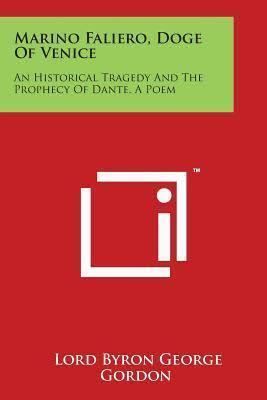7.4 /10 1 Votes7.4
Original language English Playwright George Gordon Byron | 3.7/5 Goodreads First performance 25 April 1821 | |||||||||||||||||||||||||||||||||
 | ||||||||||||||||||||||||||||||||||
Characters Marino FalieroBertuccio FalieroLioniBenintendeMichel StenoIsrael BertuccioPhilip CalendaroDagolinoBertramSignor of the NightFirst CitizenSecond CitizenThird CitizenVincenzoPietroBattistaSecretary of the Council of TenAngiolinaMarianna Date premiered 25 April 1821 (1821-04-25) Similar Sardanapalus, Manfred, The Cenci, Prometheus Unbound | ||||||||||||||||||||||||||||||||||
Marino Faliero, Doge of Venice is a blank verse tragedy in five acts by Lord Byron, published and first performed in 1821.
Contents
Synopsis
The play is set in Venice in 1355. Marino Faliero, recently elected Doge of Venice, offends one of the chief officers of state, Michel Steno. Steno retaliates by writing on the Doge's throne an indecent libel on Faliero's wife. For this he is tried by the Council of Forty and convicted, but is only sentenced to a month's imprisonment. Faliero is so outraged by this, as he believes, inadequate punishment that he secretly joins in the conspiracy of a group of malcontents to overthrow the constitution of Venice, thinking thereby to gain revenge on his enemies. The plot is discovered and Faliero is executed.
Composition and publication
Byron was inspired to take on this subject when, on examining the portraits of the Doges in the Palazzo Ducale in Venice, he discovered that the portrait of Faliero had been blacked out. The main historical source he drew on was Marino Sanuto's Vite dei Doge (published posthumously 1733). He completed the play in July 1820, by which time he was living in Ravenna, and published it in April 1821, along with his The Prophecy of Dante. He intended to dedicate it to Goethe, but delays in the post between Italy and England resulted in the play being published without a dedication. The posthumous 1832 edition of Byron's collected works included a later dedication of the play by Byron to his friend Douglas Kinnaird. Marino Faliero was translated into French in 1830 and into Italian in 1838.
First performance
Byron intended his play to be read rather than acted, and when he heard that the actor-manager Robert William Elliston intended to stage it he caused his publisher, John Murray, to obtain an injunction to prevent him. Elliston nevertheless performed it, in a version cut almost by half, at Drury Lane four days after the play was published. The reaction from both audiences and critics was lukewarm; perhaps, as Byron thought, because of the play's neoclassical form and lack of sensationalism and love interest.
Influence
The subject of Eugène Delacroix' painting The Execution of the Doge Marino Faliero (1825–26), now in the Wallace Collection in London, was suggested by Byron's play. A tragedy by Casimir Delavigne on the same subject is believed to have drawn on Byron, as well as on a story by E. T. A. Hoffmann, and Delavigne's play itself inspired Donizetti's opera Marino Faliero. Swinburne was impelled to write his own Marino Faliero by what he considered shortcomings in Byron's play.
